How to design gender-inclusive character customisation tools
At Devcom, freelance narrative designer Arden Osthof guided developers through gender-inclusive design tips
At Devcom last month, senior narrative designer Arden Osthof gave a talk entitled "Playing with gender: A design framework for character customisation," giving tips on how game makers can improve their protagonist creation tools to be more inclusive.
Osthof previously worked at Ubisoft, with past projects including the Anno series and Tom Clancy's The Division 2, and is currently a freelance narrative designer working on Rho Labyrinths' Mars Vice and Screen Juice's Morbid Metal.
They have been researching character creators since 2017 and specifically how gender-inclusive these tools can be, and what sort of options they can offer for players to express and project themselves accurately.
After an introduction on the topic, giving pointers about gender-inclusive design, Osthof's talk centred around questions you can ask yourself while making your game to be more mindful of gender representations.
The Choice, why it's problematic, and pointers to solve it
Osthof started their talk by exposing an issue regularly occurring in games or, as they call it: "The Choice."
"At the beginning of a lot of games, you might be presented with something like this: 'Are you a boy? Or are you a girl?'," they explained. "And then you get to choose one or the other. Depending on what you've chosen, you might be given an appearance. It automatically changes how NPCs talk to you or about you. And if it's a game that has some type of customisation, then maybe the customisation options might look different depending on which one you chose. Maybe if you play as a boy you have four haircuts that are kind of short-ish, and if you're a girl, then you have 12 that are long," they pointed out.
In some games, this initial decision will impact story beats and a variety of choices available to the player throughout the title, such as romance options.
"So why is this a problem, broadly speaking? Because all of these things that I've just listed, none of them are player choices. They're all choices that have been taken away from players. They only chose at the beginning – male or female – and then all of these things were just automated for them.
"Everyone benefits from having more player freedom"

"Obviously, this is limiting to non-binary players that might not see themselves in one of these two choices or trans players that don't just want this one section. But to be honest, this limits all of our players, whether they're trans or cisgender, because at the end of the day, everyone benefits from having more player freedom. And I'm sure you know some men who have long hair," they smiled.
They acknowledged that a lot of progress has been made on that front in the last few years, but mentioned heightened scrutiny and expectations from players and the press alike to look into this issue and offer more choice.
"So what are some alternatives to this? I'll give you a brief overview. What I've noticed when I bring out gender-inclusive design is that a lot of people tend to assume that in order to make it as inclusive as possible, it should look [like] a highly detailed character creator that offers every possible choice under the sun.
"And that's great because you give all of this control to the player and they can mix and match whatever they want. And they have this really large selection of physical traits and accessories. These character creators are really cool, they're popular, they work really well for the games that they're in. But there's also some other ways of doing it."
One alternative is letting players select their pronouns at the beginning of the game and how they would like to be addressed throughout. Osthof took the example of MidBoss' 2064: Read Only Memories, which was the first title they saw offering these options back in 2015.
At the beginning of the game, players are asked for their name and given a set of pronouns to choose from. The title offers a wide array of possibilities, including he/him, she/her, they/them, a few options for neo-pronouns, and an opportunity for custom input.
"Some other games might go a completely different route, choosing to go with an ambiguous protagonist and removing all gender signifiers," Osthof continued. "And by doing that, giving this projection space for all players to project themselves into."

They gave the example of BancyCo's Alone with You, where you don't know what the protagonist looks like and therefore don't get any clues about their gender, ethnicity, or age. It's deliberately left very open, which is a design choice you also see a lot in first-person games or top-down strategies, Osthof highlighted.
"So of these different ones, which is the right one, which do I recommend?" they continued. "It's a bit of a trick question because obviously there's no one perfect way. Some of the things that I've shown are in direct opposition to each other. There is really only the right way for the game that you are making. Gender is really complex so the solution that you will want for your game needs to be very tailored."
Five questions to ask yourself while making your game
- What role (if any) does gender play in your game?
This first question Osthof invited developers to think about to figure out a solution that works for their title is whether gender is important to their game at all and, if so, what role it plays. They explained that the scale here goes from something like The Sims, where gender is a prominent aspect of the gameplay, to franchises like Anno, where gender is not only irrelevant but it's questionable whether or not it's even necessary.
"Most games are going to fall somewhere in between the spectrum, where gender is going to be important in some ways, but irrelevant in others," they said.
For instance, in Dragon Age: Inquisition, it's relevant in the romance options, but irrelevant in combat. So Osthof invited game makers to dig deeper and ask themselves these questions:
- Does gender play a role in your game's theme? (identity, queerness, etc.)
- Should it impact the gameplay? (romance, conversation options, etc.)
- Is there a different gender system or species biology in the game world? (eg. in fantasy or sci-fi)
- How can gender add more depth? Would adding it detract?
- How do we refer to the player?
The second question is "very straightforward," Osthof pointed out, and revolves around how and where the game refers to the player character.
"Is it NPCs, is it in menus, is it within the narration somewhere? One way of tackling this that I've already shown you is pronouns selection. You offer a choice of pronouns and I would strongly recommend having more than two if you go through the effort of doing this," Osthof said, pointing back to the example of 2064: Read Only Memories.
"I would strongly recommend having more than two if you go through the effort of [offering pronouns selection]"
"A different way of doing something similar that I feel doesn't get as much attention, but is also super interesting, is going about it with titles and names. Because pronouns aren't always the best choice when the player isn't talked about much – a direct address also holds a lot of choice. So it might not make a lot of sense if characters always approach players directly to let them choose a third person pronoun because it never gets used."
They gave the example of Sunless Seas, where players choose a title among a list including both gendered and gender-neutral options (Madam, Sir, Citizen, Captain, and more). Osthof noted that this design choice also emphasises the tone of the title and adds to its world-building, all while combining gender with another type of roleplay.
They added that you can also avoid gender altogether and just use 'you' - but if you decide that gender is irrelevant then be careful about not accidentally introducing gendered language in other places.
Concluding that section, they reminded devs to ask themselves the following questions:
- Who or what talk to/about the player? (NPCs, narrator, menu text, etc.)
- Do you want to offer choice or use neutral language?
- How can you enhance roleplay?
- What type of language fits your game genre?
- Have you consulted a localisation manager yet?

- What is the basis of your player avatar?
Another crucial aspect of gender-inclusive design is the player's avatar and how you go about giving players a canvas to project themselves.
"All of your best intentions, like offering a lot of pronouns and unlocking all of these customisation options and mixing and matching things, are going to be pretty moot if at the end you present players with a selection of two idealised bodies, like an idealised woman and an idealised man," Osthof pointed out. "So what are some other ways of doing this without breaking budget?"
They presented three ways of solving that challenge.
One is working from a single body template and then using blend shapes, as seen in Peachy Keen Games' Calico (see image above), with different sliders allowing the players to tweak various features like their chest, waist, shoulders, facial features and so on, to create a unique body type.
For more on this topic, Osthof recommended the GDC talk "Genderf*ck 2077" by Flying Cat Studios' Aubrey Scott.
Another way to solve this challenge is to offer archetypes (like in Saints Row 5) that the player can then further customise. The advantage is that it works for both 2D and 3D, Osthof said, giving the example of character creation platform Picrew as well.

Finally, one option is to have no template at all – in Sunless Skies, players are tasked with creating a silhouette, mixing and matching facial features (see image left).
Summarising this section, Osthof invited developers to think about the following:
- How should players see their characters in-game?
- What are the genre conventions? (visual novel portraits, third person model, etc.)
- How can you break the binary to increase choice?
- What are ways to be cost-effective without falling back on 'ideal bodies'?
- How can players accurately represent themselves?
The talk's fourth question was about designing for subtlety and variety, and getting "all of those little in between steps," Osthof said, in order to give players a chance to represent themselves precisely.
"I touched on this in the previous section already, which is the idea of using sliders to get all of those little granular steps in between. That way, it can multiply the choice with every little step [and not be a] binary 'on or off'. You can do this for body types and body parts, but you can also use this for other things, like, for example, a voice pitch."
"All of your best intentions are going to be moot if at the end you present players with a selection of two idealised bodies"
Another way of getting that accuracy is going back to that idea of a super detailed character creator like in The Sims, but an alternative to this is introducing fashion and accessories, which can help the player project themselves.
For example, clothes, scars, accessories can be trans-specific, Osthof said. Top surgery scars are now an option in The Sims, but other examples include shapewear or binders, the latter being a customisation option offered in Dream Daddy for instance.
Here are a few questions game makers should ask themselves on this topic:
- What assumptions can we turn over to players to choose?
- How can we make players' choices more granular?
- How can we offer in-betweens?
- Can we multiply player choices without multiplying the workload?
- How can players express themselves in play?
Finally, in their last section, Osthof talked about the importance of letting players make statements about their identity in-game. Think about how you can create meaningful interactions with NPCs, for instance.
You can have fun with custom nicknames as well, they mentioned, giving the example of Animal Crossing and villagers giving the player nicknames. They acknowledged that it "isn't so much about gender" but is an "interesting avenue to play around."
If your title is multiplayer, think about how players can be communicating with each other via symbols (with flags representing their identity for instance), giving them a "chance for community and pride."
Oshtof offered a few questions you can ask yourself about your game to go further:
- How can players state their gender identity?
- How can players communicate with other players?
- How can players create a sense of community?
- Can players meaningfully interact with queer characters or themes?
- What's a fun way to express gender?
If you have a Devcom login, you can rewatch Arden Osthof's talk, "Playing with gender: A design framework for character customisation," on the event's page. It goes into more depth on the topic, details each of the questions mentioned above thoroughly, gives pointers about the challenges of localisation, and provides even more guidance and tips.
GamesIndustry.biz was a media partner for Devcom 2023.









